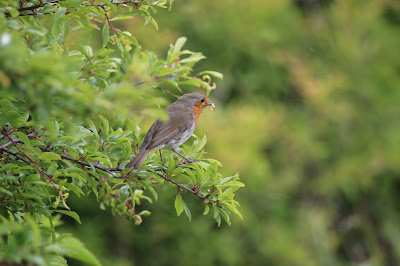One of the benefits of living on the continent is to be able to witness the spring and autumn migration of Cranes. Every spring and late into the autumn one stands a chance, either by casting one's eyes skywards or by listening for their distinct trumpeting call, of seeing the passage of these majestic birds. Sometimes they are in small groups but just as often can be seen in their hundreds. And they can be seen just about anywhere - from the car on the autobahn (always a bit risky), whilst shopping, or from your garden however big or small. However, one of the best locations to see migrating Cranes in Germany is in the Goldene Aue - roughly translated as the Golden Shire. This is a valley in eastern Germany, in the states Thuringia and Saxony-Anhalt situated between the towns Nordhausen in the west, and Sangerhausen in the east. Crucially, it is bordered by the mountain ranges of the Harz in the north, and the Windleite and Kyffhäuser in the south. These features channel migrating birds, many of whom are further attracted by the Helmstausee reservoir and its adjacent reed beds and fish ponds. This must be, especially in spring, one of the best places to watch birds in Germany.
 |
| Auleben fish ponds on the left, rough grazing and reed beds in the centre, and Helmstausee reservoir on the right. |
 |
| Reed beds and the half-empty Helmstausee reservoir behind. The south-east corner of the Harz can be seen in the distance. |
 |
| Looking west across the reed beds from the dam. |
I have visited this large and complex site many times. It originally came to my attention when driving south from the Harz to Erfurt in early May I took a short-cut which took me past the fish ponds. Subsequently, I went back to investigate and was astonished by the variety and number of birds I saw - Bluethroats, Penduline Tits, Marsh Harriers, Black and Red Kites, Ospreys, booming Bitterns, White Storks and a whole host of warblers singing from reeds and wet scrub and much, much more. Thereafter this place became a favourite of mine, even if it is a 90 minute drive from Goslar. Gradually I explored more and more habitats to the point where I now know where best and when to go. If this site has a draw-back it must be its size. A bike would be useful providing it could accommodate a camera, telescope and tripod!
 |
| A map board showing the site's main features. |
 |
| An informative information board about Cranes. |
My visit to Helmstausee the other day was species specific - I wanted to see Cranes. Last year when I visited at the same time, the whole site was enveloped with mist and I had to make do with a cacophony of trumpeting and the very occasional glimpse of grey shapes passing overhead - not terribly satisfactory! Today, however, the weather was fine and mild. I always approach this site by the fish ponds which, despite the fact that you cannot access them (the owners are very unfriendly and aggressive and I've found shot Ospreys here), are always worth scanning. Today the local fields contained not a single Crane but at least 50 Great White Egrets and even more Grey Herons. Surprisingly the fish ponds were virtually empty possibly because the owners have either scared or shot any bird daring to enter. I then drove on to the village of Auleben where one can park and then proceeded to walk towards the reservoir - see the route marked with the red arrow above. Cranes were immediately apparent wheeling and dealing in the bright blue sky. They were moving in groups of about 20 - 30 and the birds in the photographs below, seemed to be heading off south west down the Goldene Aue corridor.
 |
Close up - underside of Common Cranes - Helmstausee.
 |
| Common Cranes wheeling in the sun above the Helmstausee |
|
As walked on towards the reservoir I noticed that it was half empty and scanning with my binoculars I could see that it contained thousands of Cranes. Regrettably they were too distant for photography and I was also disappointed to confirm that, beyond several hundred Coot, the exposed mud and water contained very little else. I was unable to find a single wader or duck. But the Cranes were there - in their thousands.
 |
Common Cranes migrating - Drömling.
|
 |
| Red Kite - Helmstausee |
Turning back I observed a Red Kite and an Osprey sitting in a tree. The former are present throughout the year and are common - I have counted as many a 50 on some occasions. The Osprey was obviously passing through and as such was quite late. They can be seen here quite easily throughout the spring and autumn. Finally, walking back towards the car I found a Great Grey Shrike. There is always at least one bird here throughout the winter but the site is so large you need a bit of luck to find one. This bird showed well before flying off towards the fish ponds.
 |
| Osprey - Helmstausee. |
 |
| Great Grey Shrike - Helmstausee |














































